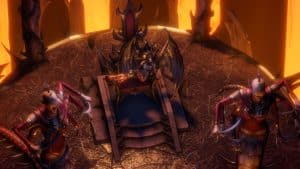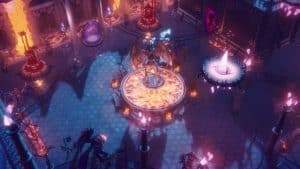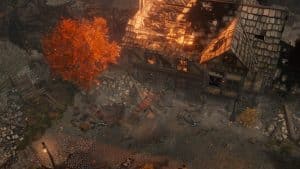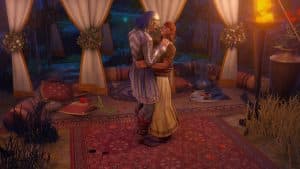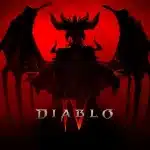Pathfinder: Wrath of the Righteous
Related Games
Description
🔥 What is Pathfinder: Wrath of the Righteous for PC
Pathfinder: Wrath of the Righteous is an expansive computer RPG developed by Owlcat Games and based on the Pathfinder tabletop role-playing system created by Paizo. Set in the dark and war-torn world of Golarion, the game casts players into the midst of a brutal demon invasion that threatens to consume the land. With its origins deeply rooted in Pathfinder’s famous adventure path of the same name, it merges classic CRPG traditions with the enormous depth and flexibility of the tabletop ruleset.
At the heart of the story lies the Fifth Crusade, a desperate struggle where mortals rally against overwhelming demonic forces. The player character, known as the Commander, becomes both a mythic hero and a leader of armies, shaping the destiny of the world. Through choices, alliances, and moral dilemmas, players influence not only the outcome of the war but also the personal paths of their companions and themselves.
The game appeals to those who crave deep tactical combat, narrative complexity, and the thrill of shaping a story through meaningful decisions. By combining party-based adventuring, large-scale strategy, and mythic transformations, Pathfinder: Wrath of the Righteous offers an RPG experience both sweeping in scope and incredibly personal in detail.
👉 Features of Pathfinder: Wrath of the Righteous
Mythic Paths and Transformations
One of the game’s most defining features is the introduction of Mythic Paths, which allow players to ascend to near-divine levels of power. These paths range from angelic champions of light to terrifying liches or cunning tricksters, and each dramatically alters gameplay and narrative possibilities. Choosing a Mythic Path is not just a mechanical upgrade; it redefines how allies, enemies, and even the world itself respond to your character.
Epic Party-Based Roleplaying
Just like the classic CRPGs it draws inspiration from, Wrath of the Righteous thrives on building a diverse party of companions, each with their own backstories, personal quests, and moral struggles. Every companion reacts to your choices, meaning alliances can strengthen, friendships can collapse, and romances can blossom depending on your path.
Tactical Combat with Depth
The game offers both real time with pause and turn-based combat modes, giving players the flexibility to approach encounters in their preferred style. This dual system makes the complex Pathfinder rules accessible to newcomers while still rewarding veterans who want precise tactical control. Spell interactions, terrain effects, and enemy abilities create battles that demand both preparation and improvisation.
Crusade Management
Beyond party adventures, the game introduces a layer of strategic gameplay where you command armies in the Fifth Crusade. You recruit generals, deploy troops, and wage battles against the demon hordes on a strategic map, blending RPG storytelling with turn-based war strategy. Your performance in this layer directly affects the main narrative, making leadership choices as important as personal heroics.
Moral and Narrative Complexity
Pathfinder: Wrath of the Righteous is built on a foundation of choice and consequence. Every major decision has rippling effects, shaping not only the world but also your companions and your Mythic journey. The moral dilemmas rarely present simple answers, forcing players to weigh ideals against pragmatism.
Gameplay
Party-Based Adventuring
The core of gameplay revolves around classic RPG adventuring with a party of up to six characters. You explore dangerous dungeons, navigate city intrigues, and travel through demon-infested landscapes. Quests are multifaceted, often offering multiple solutions depending on your skills, alignment, or Mythic Path. The sheer variety ensures no two playthroughs feel the same.
Tactical Combat Systems
Combat remains one of the most engaging parts of the game, with the choice between real-time-with-pause and fully turn-based systems. Each style changes how battles flow, with turn-based allowing careful consideration of Pathfinder’s many abilities, while real-time favors speed and momentum. Encounters range from skirmishes against cultists to epic battles with towering demons that require clever use of spells, positioning, and synergies between party members.
Mythic Path Progression
As you progress, your character gains Mythic levels that unlock staggering new powers. An Angel might smite demons with holy fire, while a Lich commands armies of undead, and an Aeon bends time itself. Each path alters the gameplay loop, offering unique mechanics, questlines, and even alternate endings to the story.
Crusade and Strategic Layer
The Fifth Crusade requires more than personal heroics, which is why the crusade management system exists. You raise armies, build fortifications, and make strategic decisions that impact the war effort. Victories and failures on this front influence story progression, granting access to allies or cutting off resources if mismanaged.
Roleplaying and Choices
Every dialogue option, quest decision, and battlefield choice contributes to the Commander’s alignment and reputation. The roleplaying element is not cosmetic but structural: lawful heroes, chaotic tricksters, ruthless necromancers, and merciful redeemers all leave different marks on the world. This depth encourages replayability, since each new alignment and Mythic Path feels like a new game altogether.
Graphics
Atmospheric Art Direction
Pathfinder: Wrath of the Righteous uses an isometric perspective, but within that limitation it achieves striking atmosphere. The environments reflect the devastation of war and corruption, from ruined fortresses to surreal demon-infested realms. The art direction emphasizes contrast, making sanctuaries of light feel more sacred when set against endless voids of chaos.
Character and Enemy Design
Companion and enemy designs are heavily inspired by Pathfinder’s tabletop illustrations, adapted with more detail and flair for the digital medium. Mythic transformations such as Angelic wings or Lich’s skeletal forms look dramatic and imposing, visually reinforcing the impact of your choices. Demons are grotesque and varied, constantly reminding players of the horror they face.
Spell Effects and Combat Visuals
The visual presentation of spells and combat effects helps translate the complexity of the Pathfinder system into something thrilling to watch. Firestorms engulf entire battlefields, while protective wards shimmer around allies. Each Mythic Path gains unique visual cues, making your progression feel visible as well as mechanical.
Performance and Technical Aspects
While the game is demanding at times, optimization patches have improved stability and performance significantly since launch. On modern systems, the game runs smoothly, though large-scale battles or modded setups can strain hardware. Nevertheless, the richness of its world design rewards players who push for higher settings.
Pros and Cons
✔️ Pros
- Immense depth of roleplaying choices with far-reaching narrative consequences
- Flexible combat system offering both turn-based and real-time-with-pause modes
- Unique Mythic Path progression that transforms both story and gameplay
- Engaging companions with rich personalities and quests
- Strategic Crusade layer adds variety beyond dungeon crawling
❌ Cons
- Can be overwhelming for newcomers due to Pathfinder’s complexity
- Some pacing issues with long battles or drawn-out crusade segments
- Technical hiccups and occasional bugs, especially in larger encounters
ℹ️ Game information
⭐ Installation Instructions
- The game is fully complete, you just need to install it, so there is no need to unpack it or download it from other sources.
- Just run the Pathfinder: Wrath of the Righteous.exe installation file.
- Simply launch the game from shortcut desktop.
⚙️ System Requirements
✅ Minimum:
- OS: Windows 7 64-Bit
- Processor: Intel(R) Core(TM) i3-2310M CPU @ 2.10GHz
- Memory: 6 GB RAM
- Graphics: NVIDIA GeForce 940M
- DirectX: Version 11
- Network: Broadband Internet connection
- Storage: 50 GB available space
✅ Recommended:
- OS: Windows 10 64-Bit
- Processor: Intel Core i7 CPU 920 @ 2.67GHz
- Memory: 8 GB RAM
- Graphics: NVIDIA GeForce GTX 1050 Ti
- DirectX: Version 11
- Network: Broadband Internet connection
- Storage: 50 GB available space
Images
